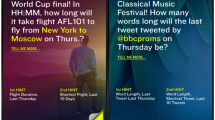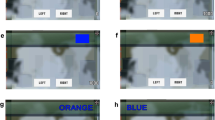Abstract
The conjunction fallacy is a classical judgment bias that was argued to be a robust cognitive illusion insensitive to the positive effect of incentivization. We conducted a meta-analysis of the literature (n = 3276) and found that although most studies did not report a significant effect of incentivization, the results across studies show a significant positive effect for incentivization, d = 0.19, with an odds ratio of 1.40 for answering correctly when incentivized. There was no moderating effect of payoff size despite the differences in incentive value between studies. Additionally, the effect was relatively smaller when examining absolute differences in the probability of correct judgment instead of odds ratios, suggesting that it may be partly driven by studies with low baseline performance. These findings join those of other judgment-bias studies to suggest a small but nevertheless robust debiasing effect of incentivization.




Similar content being viewed by others
Data availability
The data for this meta-analysis is available on https://osf.io/dh7sb/?view_only=262aeec537094702bcb508be3a50ce07
Notes
Likewise, the liberal paternalism (or “nudge”) approach was originally based on the assumption that people cannot in practice increase their cognitive effort (e.g., through incentives) so as to overcome judgment and decision biases (Thaler & Sunstein, 2008).
On average the rate of correct choices in the non-incentivized condition was 45% compared to 55% in the incentivized condition.
Rather, the two metrics were used as robustness tests. Formally comparing the two statistics likely requires a larger number of studies.
References
Arkes, H. R. (1991). Costs and benefits of judgment errors: Implications for debiasing. Psychological Bulletin, 110, 486–498.
Awasthi, V., & Pratt, J. (1990). The effects of monetary incentives on effort and decision performance: The role of cognitive characteristics. Accounting Review, 65, 797–811.
Baillon, A., Bleichrodt, H., & Granic, G.D. (2022). Incentives in surveys. Working paper, available at http://docplayer.net/164787861-Incentives-in-surveys.html
Begg, C. B., & Mazumdar, M. (1994). Operating characteristics of a rank correlation test for publication bias. Biometrics, 50, 1088–1101.
Brañas-Garza, P., Kujal, P., & Lenkei, B. (2019). Cognitive reflection test: Whom, how, when. Journal of Behavioral and Experimental Economics, 82, 101455.
Camerer, C. F., & Hogarth, R. M. (1999). The effects of financial incentives in experiments: A review and capital-labor-production framework. Journal of Risk and Uncertainty, 19, 7–42.
Cerasoli, C. P., Nicklin, J. M., & Ford, M. T. (2014). Intrinsic motivation and extrinsic incentives jointly predict performance: A 40-year meta-analysis. Psychological Bulletin, 140, 980–1008.
Chandrashekar, S.P., Cheng, Y.H., Fong, C.L., Leung, Y.C., Wong, Y.T., Cheng, B.L., & Feldman, G. (2021). Frequency estimation and semantic ambiguity do not eliminate conjunction bias, when it occurs: Replication and extension of Mellers, Hertwig, and Kahneman (2001). Meta-Psychology, 5, MP.2020.2474.
Charness, G., Karni, E., & Levin, D. (2008). On the conjunction fallacy in probability judgment: New experimental evidence. Johns Hopkins University working paper. See: https://papers.ssrn.com/sol3/papers.cfm?abstract_id=1155219
Charness, G., Karni, E., & Levin, D. (2010). On the conjunction fallacy in probability judgment: New experimental evidence regarding Linda. Games and Economic Behavior, 68, 551–556.
Cortina, J. M., & Landis, R. S. (2009). When small effect sizes tell a big story, and when large effect sizes don’t. In C. E. Lance & R. J. Vandenberg (Eds.), Statistical and methodological myths and urban legends: Doctrine, verity and fable in the organizational and social sciences (pp. 287–308). Routledge.
Dale, D., Rudski, J., Schwarz, A., & Smith, E. (2007). Innumeracy and incentives: A ratio bias experiment. Judgment and Decision Making, 2, 243–250.
Devetag, G., Ceccacci, F., & De Salvo, P. (2013). Do reputation concerns make behavioral biases disappear? The conjunction fallacy on Facebook and Mechanical Turk. Working paper available in https://papers.ssrn.com/sol3/papers.cfm?abstract_id=2263179
Duval, S., & Tweedie, R. (2000). Trim and fill: A simple funnel-plot–based method of testing and adjusting for publication bias in meta-analysis. Biometrics, 56, 455–463.
Egger, M., Smith, G. D., Schneider, M., & Minder, C. (1997). Bias in meta-analysis detected by a simple, graphical test. British Medical Journal, 315, 629–634.
Enke, B., Gneezy, U., Hall, B., Martin, D., Nelidov, V., Offerman, T., & van de Ven, J. (2022). Cognitive biases: Mistakes or missing stakes? In press.
Epley, N., & Gilovich, T. (2005). When effortful thinking influences judgmental anchoring: Differential effects of forewarning and incentives on self-generated and externally provided anchors. Journal of Behavioral Decision Making, 18, 199–212.
Erev, I., & Cohen, B. L. (1990). Verbal versus numerical probabilities: Efficiency, biases, and the preference paradox. Organizational Behavior and Human Decision Processes, 45, 1–18.
Frederick, S. (2005). Cognitive reflection and decision making. Journal of Economic Perspectives, 19, 25–42.
Gao, G. (2009). Probability error in diagnosis: The conjunction fallacy among beginning medical students. Family Medicine, 41, 262–265.
Harrison, G. W. (1994). Expected utility theory and the experimentalists. In J. D. Hey (Ed.), Experimental economics (pp. 43–76). Springer-Verlag.
Hedges, L. V., & Olkin, I. (2014). Statistical methods for meta-analysis. Academic press.
Hertwig, R., & Ortmann, A. (2001). Experimental practices in economics: A methodological challenge for psychologists? Behavioral and Brain Sciences, 24, 383–403.
Isler, O., & Yilmaz, O. (2022). How to activate intuitive and reflective thinking in behavior research? A comprehensive examination of experimental technique. Working paper. Retrieved from https://psyarxiv.com/jcyt2/download?format=pdf
Jackson, D., & Turner, R. (2017). Power analysis for random-effects meta-analysis. Research Synthesis Methods, 8, 290–302.
Kahneman, D. (1973). Attention and effort. Prentice-Hall.
Kahneman, D. (1991). Judgment and decision making: A personal view. Psychological Science, 2, 142–145.
Kim, A. J., Lee, D. S., & Anderson, B. A. (2021). The influence of threat on the efficiency of goal-directed attentional control. Psychological Research Psychologische Forschung, 85, 980–986.
Kontopantelis, E., & Reeves, D. (2012). Performance of statistical methods for meta-analysis when true study effects are non-normally distributed: A comparison between DerSimonian–Laird and restricted maximum likelihood. Statistical Methods in Medical Research, 21, 657–659.
Larrick, R. P. (2004). Debiasing. In D. Koehler & N. Harvey (Eds.), Blackwell handbook of judgment and decision making (pp. 316–337). Blackwell Publishing.
Lawson, M. A., Larrick, R. P., & Soll, J. B. (2020). Comparing fast thinking and slow thinking: The relative benefits of interventions, individual differences, and inferential rules. Judgment and Decision Making, 15, 660–684.
Lefebvre, M., Vieider, F. M., & Villeval, M. C. (2011). The ratio bias phenomenon: Fact or artifact? Theory and Decision, 71, 615–641.
Levin, I. P., Chapman, D. P., & Johnson, R. D. (1988). Confidence in judgments based on incomplete information: An investigation using both hypothetical and real gambles. Journal of Behavioral Decision Making, 1, 29–41.
McInnes, M. D. F., Moher, D., Thombs, B. D., McGrath, T. A., Bossuyt, P. M., the PRISMA-DTA Group, & Willis, B. H. (2018). Preferred reporting items for a systematic review and meta-analysis of diagnostic test accuracy studies: The PRISMA-DTA statement. Journal of the American Medical Association, 319, 388–396.
Mellers, B., Hertwig, R., & Kahneman, D. (2001). Do frequency representations eliminate conjunction effects? An exercise in adversarial collaboration. Psychological Science, 12, 269–275.
Navon, D., & Gopher, D. (1979). On the economy of the human processing system. Psychological Review, 86, 214–253.
Richter, M., & Gendolla, G. H. E. (2009). The heart contracts to reward: Monetary incentives and preejection period. Psychophysiology, 46, 451–457.
Sánchez-Meca, J., Marín-Martínez, F., & Chacón-Moscoso, S. (2003). Effect-size indices for dichotomized outcomes in meta-analysis. Psychological Methods, 8, 448–467.
Shafir, E., & LeBoeuf, R. A. (2002). Rationality. Annual Review of Psychology, 53, 419–517.
Shaw, J. D., & Gupta, N. (2015). Let the evidence speak again! Financial incentives are more effective than we thought. Human Resource Management Journal, 25, 281–293.
Sjastad, H., & Baumeister, R.F. (2020). Fast optimism, slow realism? Causal evidence for a two-step model of future thinking. Working paper, available at https://psyarxiv.com/v6ksu/
Stolarz-Fantino, S., Fantino, E., Zizzo, D. J., & Wen, J. (2003). The conjunction effect: New evidence for robustness. American Journal of Psychology, 116, 15–34.
Szollosi, A., Bago, B., Szaszi, B., & Aczel, B. (2017). Exploring the determinants of confidence in the bat-and-ball problem. Acta Psychologica, 180, 1–7.
Thaler, R. H., & Sunstein, C. R. (2008). Nudge. Yale University Press.
Travers, E., Rolison, J. J., & Feeney, A. (2016). The time course of conflict on the cognitive reflection test. Cognition, 150, 109–118.
Tversky, A., & Kahneman, D. (1982). Judgments of and by representativeness. In D. Kahneman, P. Slovic, & A. Tversky (Eds.), Judgment under uncertainty: Heuristics and biases (pp. 84–100). Cambridge University Press.
Tversky, A., & Kahneman, D. (1983). Extensional versus intuitive reasoning: The conjunction fallacy in probability judgment. Psychological Review, 90, 293–315.
Viechtbauer, W. (2010). Conducting meta-analyses in R with the metaphor package. Journal of Statistical Software, 36, 1–48.
von Hippel, P. T. (2015). The heterogeneity statistic I2 can be biased in small meta-analyses. BMC Medical Research Methodology, 15, 35.
Wright, R. A. (1998). Ability perception and cardiovascular response to behavioral challenge. In M. Kofta, G. Weary, & G. Sedek (Eds.), Control in action: Cognitive and motivational mechanisms (pp. 197–232). Plenum Press.
Wright, W. F., & Anderson, U. (1989). Effects of situation familiarity and financial incentives on use of the anchoring and adjustment heuristic for probability assessment. Organizational Behavior and Human Decision Processes, 44, 68–82.
Xue, G., Lu, Z., Levin, I. P., Weller, J. A., Li, X., & Bechara, A. (2009). Functional dissociations of risk and reward processing in the medial prefrontal cortex. Cerebral Cortex, 19, 1019–1027.
Yechiam, E., & Hochman, G. (2013). Losses as modulators of attention: Review and analysis of the unique effects of losses over gains. Psychological Bulletin, 139, 497–518.
Yechiam, E., & Hochman, G. (2014). Loss attention in a dual task setting. Psychological Science, 25, 494–502.
Yechiam, E., & Zeif, D. (2022). Revisiting the effect of incentivization on cognitive reflection: A meta-analysis. Journal of Behavioral Decision Making., 36, e2286.
Young, M. S., & Stanton, N. A. (2002). Malleable attentional resources theory: A new explanation for the effects of mental underload on performance. Human Factors, 44, 365–375.
Zeif, D. (2022). The effect of strategies of attention on judgment and decision-making performance. Unpublished doctoral dissertation. Technion – Israel Institute of Technology.
Zizzo, J. Z., Stolarz-Fantino, S., Wen, J., & Fantino, E. (2000). A violation of the monotonicity axiom: Experimental evidence on the conjunction fallacy. Journal of Economic Behavior & Organization, 41, 263–276.
Funding
The study was supported by a grant from the Technion Research & Development Foundation to the second author and by the Max Wertheimer Minerva Center for Cognitive Studies.
Author information
Authors and Affiliations
Contributions
EY and DZ conceptualized the study and conducted the search for papers. EY wrote the first draft of the paper and both authors reviewed the paper.
Corresponding author
Ethics declarations
Conflict of interest
The authors declare that they have no conflict of interest.
Ethical approval
This article does not contain any studies with human participants or animals performed by any of the authors.
Additional information
Publisher's Note
Springer Nature remains neutral with regard to jurisdictional claims in published maps and institutional affiliations.
Supplementary Information
Below is the link to the electronic supplementary material.
Rights and permissions
Springer Nature or its licensor (e.g. a society or other partner) holds exclusive rights to this article under a publishing agreement with the author(s) or other rightsholder(s); author self-archiving of the accepted manuscript version of this article is solely governed by the terms of such publishing agreement and applicable law.
About this article
Cite this article
Yechiam, E., Zeif, D. The effect of incentivization on the conjunction fallacy in judgments: a meta-analysis. Psychological Research 87, 2336–2344 (2023). https://doi.org/10.1007/s00426-023-01837-5
Received:
Accepted:
Published:
Issue Date:
DOI: https://doi.org/10.1007/s00426-023-01837-5




